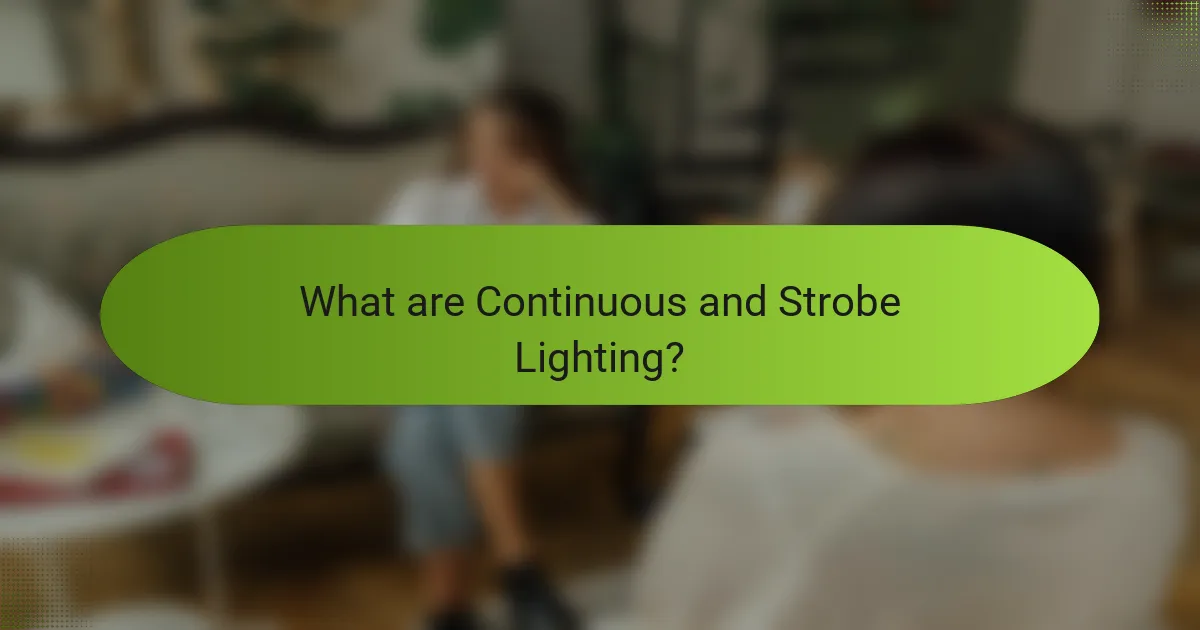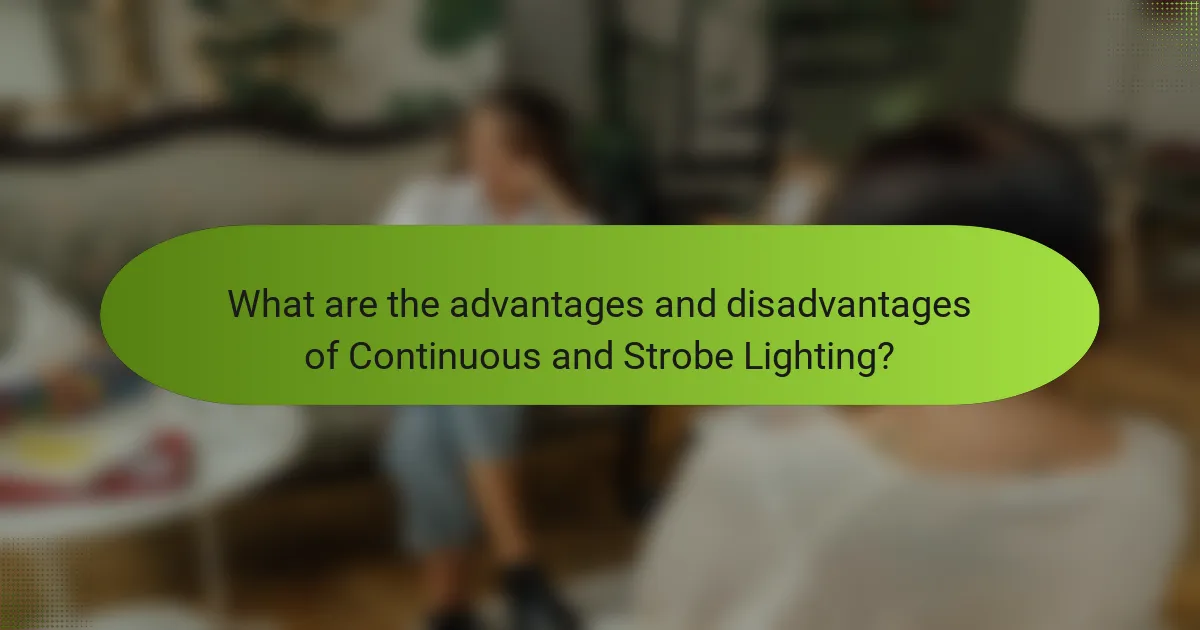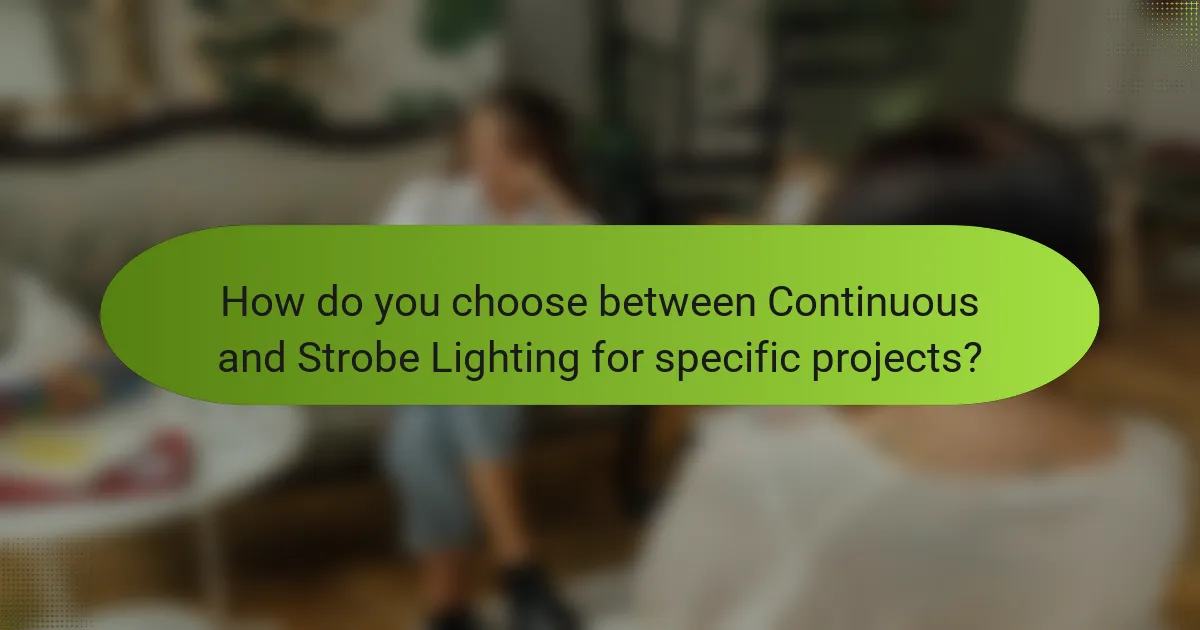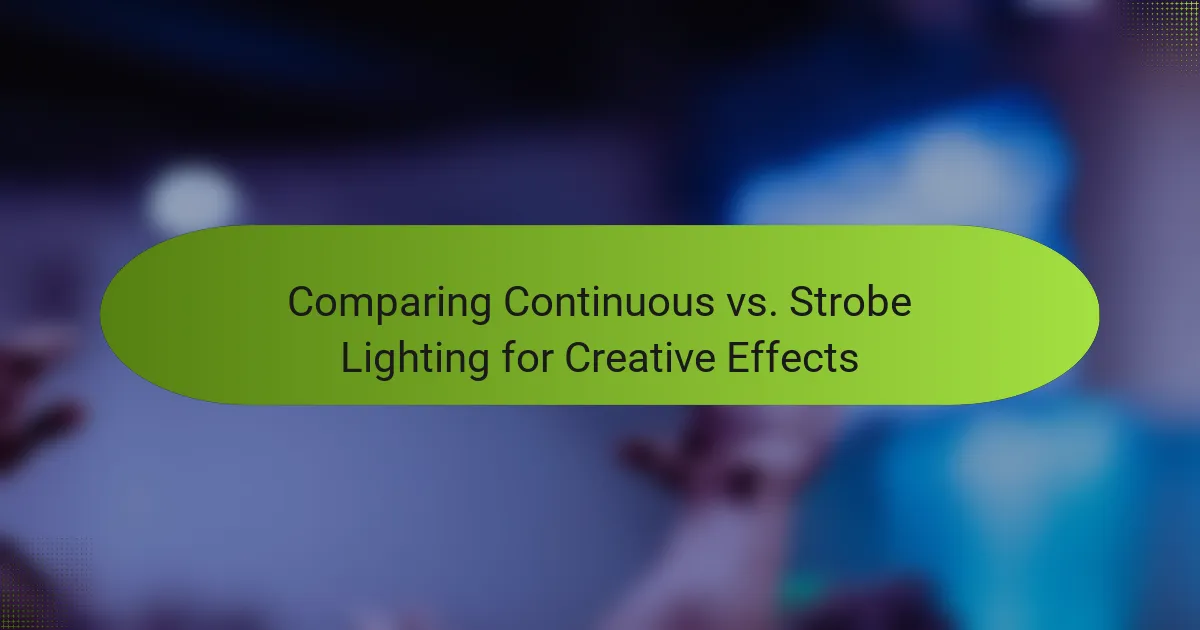
What are Continuous and Strobe Lighting?
Continuous lighting refers to a type of lighting that remains on constantly during a shoot. It provides a steady light source, allowing for real-time visibility of how the light affects the scene. Continuous lighting is typically used in video production and photography for its simplicity and ease of use.
Strobe lighting, on the other hand, emits a brief burst of light, usually lasting a fraction of a second. This type of lighting is often used in photography to freeze motion and capture sharp images. Strobe lights are powerful and can be adjusted for intensity, making them suitable for various lighting conditions.
Both continuous and strobe lighting serve distinct purposes in creative photography and videography. Continuous lighting allows for easy adjustments and monitoring of light, while strobe lighting excels in capturing fast-moving subjects with precision.
How do Continuous and Strobe Lighting differ in functionality?
Continuous lighting provides a constant light source, allowing photographers to see how shadows and highlights fall in real-time. This type of lighting is typically used for video and still photography where consistent illumination is necessary. Strobe lighting, on the other hand, emits short bursts of light, which can freeze motion and create dramatic effects. Strobe lights are commonly used in studio photography for high-speed captures. The key difference lies in their output; continuous lighting is steady, while strobe lighting is intermittent. This functionality affects how each is used creatively in different scenarios.
What are the key characteristics of Continuous Lighting?
Continuous lighting provides a constant light source for photography and videography. This type of lighting allows users to see the effects of light in real-time. It typically uses fluorescent, LED, or tungsten bulbs. Continuous lighting is ideal for beginners due to its simplicity and ease of use. It offers consistent color temperature, which aids in achieving accurate color representation. This lighting method allows for better control of shadows and highlights. Continuous lighting is versatile, suitable for various settings including studio and outdoor shoots. It also enables easy adjustments to light intensity and direction during a shoot.
What are the key characteristics of Strobe Lighting?
Strobe lighting is characterized by its ability to produce brief, intense bursts of light. These flashes typically last for a fraction of a second. Strobe lights can freeze motion effectively, making them ideal for photography and videography. They are often adjustable in terms of power and frequency. Strobe lighting can create dramatic effects in creative projects. The light produced is usually very bright, allowing for high-speed captures. This type of lighting is commonly used in studios and for event photography. Strobe lights can be triggered remotely, providing flexibility in positioning.
Why are Continuous and Strobe Lighting used in creative effects?
Continuous and strobe lighting are used in creative effects to enhance visual storytelling. Continuous lighting provides a constant light source, allowing for real-time adjustments and easier visualization of shadows and highlights. This makes it ideal for video production and live events. Strobe lighting, on the other hand, emits brief bursts of light. This feature freezes motion effectively, making it suitable for high-speed photography and capturing dynamic scenes.
Both lighting types serve distinct purposes in creative applications. For instance, photographers may use continuous lighting for portraits and strobe lights for action shots. The choice between them depends on the desired effect and the specific needs of the project.
What creative effects can be achieved with Continuous Lighting?
Continuous lighting allows for various creative effects in photography and videography. It provides consistent illumination, enabling real-time adjustments to exposure and composition. This type of lighting is ideal for creating soft shadows, enhancing textures, and achieving natural-looking skin tones. Additionally, continuous lighting facilitates the use of colored gels for mood enhancement. It allows for easy experimentation with light positioning and intensity. The ability to see the light effect in real-time aids in creative decision-making. Continuous lighting is also beneficial for long exposure techniques, capturing motion blur effectively.
What creative effects can be achieved with Strobe Lighting?
Strobe lighting can achieve various creative effects in photography and videography. It allows for the freezing of motion, capturing sharp details in fast-moving subjects. This effect is particularly useful in sports photography or action shots. Strobe lighting can also create dramatic shadows and highlights, enhancing the three-dimensionality of subjects. Additionally, it enables the use of multiple exposures in a single frame, allowing for artistic compositions. The rapid bursts of light can produce a unique ambiance, altering the mood of a scene. Strobe lighting is often employed in fashion photography to emphasize textures and colors. It can also be synchronized with camera shutters to create light trails or ghosting effects, adding creativity to images.

What are the advantages and disadvantages of Continuous and Strobe Lighting?
Continuous lighting provides a constant source of illumination. This allows for real-time adjustments and easier subject visibility. It is beneficial for video production and photography where consistent lighting is essential. However, continuous lighting can generate heat and consume more power.
Strobe lighting, on the other hand, offers powerful bursts of light. This can freeze motion and create sharp images in fast-paced environments. Strobes are typically more energy-efficient and can produce higher intensity light. Nonetheless, they require time to recharge between flashes, which can interrupt shooting.
In summary, continuous lighting is advantageous for its consistency and ease of use, while strobe lighting excels in freezing motion and energy efficiency. Each type has specific benefits and limitations depending on the creative context.
What are the benefits of using Continuous Lighting?
Continuous lighting provides consistent illumination for photography and videography. It allows creators to see how light affects their subjects in real-time. This type of lighting simplifies the setup process, reducing the need for complex adjustments. Continuous lighting is particularly beneficial for beginners, as it is easier to use than strobe lighting. It also facilitates accurate color representation, as the light remains constant throughout the shoot. Additionally, continuous lighting is ideal for video production, where changing light conditions can disrupt recording. Many professionals prefer it for product photography, as it helps avoid harsh shadows. Overall, continuous lighting enhances creativity and efficiency in visual projects.
How does Continuous Lighting enhance visibility and control?
Continuous lighting enhances visibility by providing a consistent and steady source of illumination. This constant light allows users to see exactly how their subjects will appear in the final image. It eliminates the guesswork associated with flash photography, where the light only appears momentarily. With continuous lighting, adjustments can be made in real-time, ensuring optimal exposure and composition. This type of lighting is particularly beneficial for video production, as it creates a natural look and feel. Studies show that consistent lighting improves focus and reduces shadows, leading to clearer images. Additionally, continuous lighting offers greater control over the lighting environment, allowing for precise adjustments to intensity and direction.
What are the limitations of Continuous Lighting?
Continuous lighting has several limitations. One major limitation is heat generation. Continuous lights can produce significant heat, potentially leading to discomfort during long shoots. Another limitation is the intensity of light. Continuous lighting may not provide enough brightness for high-speed photography. Additionally, continuous lights can create unwanted shadows. This can affect the overall quality of the image. Another limitation is the color temperature consistency. Continuous lights may vary in color temperature, impacting color accuracy. Lastly, continuous lighting setups can be bulky and difficult to manage. This can hinder mobility and flexibility during shoots.
What are the benefits of using Strobe Lighting?
Strobe lighting provides several benefits for photography and videography. It produces short bursts of intense light. This allows for freezing motion, capturing sharp images of fast-moving subjects. Strobe lights can also create dramatic effects through shadows and highlights. They offer greater control over exposure compared to continuous lighting. Strobe lights enable photographers to work in various lighting conditions, including bright environments. They are energy-efficient, as they only draw power when firing. Additionally, strobe lighting can enhance color saturation and contrast in images. These advantages make strobe lighting a preferred choice for many professionals in creative fields.
How does Strobe Lighting contribute to freezing motion?
Strobe lighting contributes to freezing motion by emitting brief bursts of intense light. These flashes occur at very short intervals, typically in milliseconds. This rapid illumination captures fast-moving subjects without motion blur. The high-speed exposure effectively “freezes” the action, allowing for sharp, clear images. Research indicates that strobe lights can achieve shutter speeds equivalent to 1/1000 of a second or faster. This capability makes them ideal for photographing sports and dynamic scenes. The precise timing of the strobe flash coincides with the subject’s movement, enhancing the effect of freezing motion.
What are the limitations of Strobe Lighting?
Strobe lighting has several limitations. It can create a harsh, unnatural look if not used carefully. Strobe lights may also cause discomfort or distraction for subjects due to their intense flashes. Additionally, they require specific synchronization with cameras, which can complicate setups. Strobe lighting may not be suitable for continuous shooting, as it operates in short bursts. This can result in missed moments in dynamic scenes. Moreover, strobe lights often need additional power sources, limiting portability. Lastly, they can be expensive compared to continuous lighting options.

How do you choose between Continuous and Strobe Lighting for specific projects?
Choose continuous lighting for projects requiring consistent illumination, like video shoots. Continuous lights allow real-time adjustments and are easier for beginners. They provide a stable light source, making it simple to see the effects immediately.
Opt for strobe lighting for high-speed photography or when capturing motion. Strobe lights produce brief bursts of intense light, freezing action effectively. They are often more powerful than continuous lights, allowing for greater control over exposure.
Consider the project’s requirements to determine the best option. For example, continuous lighting is ideal for interviews, while strobe lighting suits sports photography.
What factors should be considered when selecting lighting type?
When selecting a lighting type, consider the purpose of the lighting. Different lighting types serve various functions, such as ambiance or task lighting. Assess the environment where the lighting will be used. Indoor and outdoor settings may require different lighting solutions. Evaluate the color temperature of the light, as it impacts the mood and visual appeal.
Consider the intensity and brightness levels needed for your specific application. This affects how subjects are illuminated and perceived. Look at energy efficiency, as some lighting types consume more power than others. This can impact long-term costs. Finally, consider the ease of use and setup, especially for creative projects where flexibility may be required.
How do project requirements influence the choice of lighting?
Project requirements significantly influence the choice of lighting. These requirements dictate the desired mood, visibility, and functionality of the lighting in a project. For instance, a project focused on product photography may require consistent and even lighting to showcase details accurately. In contrast, a project aiming for dramatic effects might benefit from strobe lighting to create dynamic contrasts and shadows.
Additionally, the project’s timeline affects lighting choices. Continuous lighting is often preferred for real-time adjustments and ease of use. Conversely, strobe lighting may be selected for its ability to freeze motion in fast-paced environments.
Furthermore, the budget can limit lighting options. Continuous lighting setups tend to be more affordable, while high-quality strobe lights can be more expensive. Lastly, the technical expertise of the team also plays a role. If the team is more familiar with a specific type of lighting, that familiarity will influence the choice to ensure effective execution.
What role does the environment play in lighting selection?
The environment significantly influences lighting selection. Different settings require specific lighting to enhance visual effects. For instance, outdoor environments may need natural light considerations. Indoor spaces often require artificial lighting adjustments based on wall colors and furniture. The time of day also impacts lighting choices, especially in photography. Additionally, the mood of the environment dictates the light’s intensity and color temperature. Warmer lights create a cozy atmosphere, while cooler lights can evoke a more clinical feel. Understanding the environment ensures optimal lighting for desired creative effects.
What are some best practices for using Continuous and Strobe Lighting?
Use continuous lighting for consistent exposure and easy adjustments. It allows for real-time visibility of shadows and highlights. Adjust the intensity to achieve the desired effect without sudden changes. Strobe lighting is ideal for freezing motion and capturing sharp details. Set the strobe to a low power for softer lighting effects. Use light modifiers like softboxes or umbrellas to diffuse strobe light. Always consider the ambient light when combining both types. Test different angles to find the most flattering light for your subject.
How can you effectively set up Continuous Lighting for optimal effects?
To effectively set up Continuous Lighting for optimal effects, position the light source at a 45-degree angle to the subject. This angle helps create natural shadows and depth. Use softboxes or diffusers to soften the light and reduce harsh shadows. Adjust the intensity of the lights to achieve the desired exposure without overexposing the highlights. Ensure the lighting is consistent throughout the shoot to maintain uniformity in your images. Additionally, consider the color temperature of the lights to match the ambient light, which can enhance the overall quality of the photos. Continuous lighting allows for real-time adjustments, making it easier to see the effects immediately. This setup is commonly used in video production and photography for its versatility.
What tips are essential for using Strobe Lighting successfully?
To use strobe lighting successfully, ensure proper positioning of the light source. Place the strobe at an angle to create depth in the image. Adjust the power settings to control brightness effectively. Use a light meter to measure exposure accurately. Incorporate modifiers like softboxes to soften shadows. Experiment with different flash durations for varied effects. Sync the strobe with your camera’s shutter speed for optimal results. Lastly, practice regularly to understand the nuances of strobe lighting.
The main entity of this article is the comparison between continuous and strobe lighting, two distinct types of lighting used in photography and videography. Continuous lighting provides a steady light source for real-time visibility and ease of adjustment, making it suitable for video production and beginners. In contrast, strobe lighting emits brief bursts of intense light, allowing for the freezing of motion and capturing sharp images, ideal for dynamic scenes. The article discusses the key characteristics, advantages, and limitations of each lighting type, as well as best practices for their effective use in creative projects.
